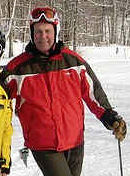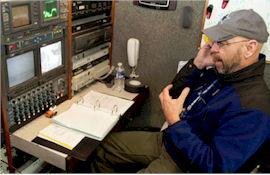Hello Everyone –
Now that it seems that cold weather is finally getting ready to set in over the region, I just thought for my first column of the season, I would check out with some weather experts on what they thought was going to take place this season for skiers and snowboarders in the Southeast and mid-Atlantic regions. I know there has been some snowfall throughout the region this fall but not enough to write home about and the snowguns are operating whenever possible as the majority of the resorts should be opening soon. So I just wanted to look out into the future a bit to see how some weathermen felt about the upcoming season. So here goes.
 We first spoke with Meteorologist Doug Harlow of WCHS-TV, Charleston, West Virginia and here are his thoughts: The previous two winters were a boon for area ski resorts thanks to a number of favorable parameters. In the 2009/10 Winter, an El Nino, (warming of equatorial Pacific waters) combined with unusually low pressure in the Polar regions to provide a near-perfect combination of cold air and moisture that resulted in record snows across much of the Ohio Valley and East Coast. The 2010/11 Winter featured a La Nina pattern (cooling of the equatorial Pacific) that resulted in enhanced precipitation and…at least early on…on a good supply of cold air. A strong "blocking" pattern of high pressure over Greenland helped steer cold air well south across the lower 48 and resulted in a very cold, snowy December, including a "White Christmas" in much of the Southeast. As tends to be typical of La Nina Winters…the latter half turned much warmer, especially after Groundhog Day.
We first spoke with Meteorologist Doug Harlow of WCHS-TV, Charleston, West Virginia and here are his thoughts: The previous two winters were a boon for area ski resorts thanks to a number of favorable parameters. In the 2009/10 Winter, an El Nino, (warming of equatorial Pacific waters) combined with unusually low pressure in the Polar regions to provide a near-perfect combination of cold air and moisture that resulted in record snows across much of the Ohio Valley and East Coast. The 2010/11 Winter featured a La Nina pattern (cooling of the equatorial Pacific) that resulted in enhanced precipitation and…at least early on…on a good supply of cold air. A strong "blocking" pattern of high pressure over Greenland helped steer cold air well south across the lower 48 and resulted in a very cold, snowy December, including a "White Christmas" in much of the Southeast. As tends to be typical of La Nina Winters…the latter half turned much warmer, especially after Groundhog Day.
For this Winter, La Nina remains in play although in a weakened form. However, several factors that were present last year appear to be lacking this time around, and that suggests much less snow and cold intrusions. One parameter is the Arctic Oscillation, which looks at air pressure in the polar regions. These "oscillations" can be positive or negative, and a positive AO means low pressure in the polar regions. This tends to keep the jet stream zonal (blowing west to east, not north to south) and that keeps the arctic air from moving south into the U.S. Related to the AO is the NAO (North Atlantic Oscillation) which indicates the air pressure setup around Greenland. A positive NAO tends to indicate low pressure over the Greenland region while a negative NAO indicates an area of high pressure. The latter is called a "block" and when we see that over Greenland, watch out…arctic air gets shunted into the northern and eastern U.S.
The AO and NAO have been very positive recently and are more or less forecast to remain so for at least another 10 days. This suggests to me a lack of really cold air in the East/Southeast U.S. anytime soon. These two indexes change all the time, and while we can forecast them reasonably accurately in a 1-2 week frame things are much murkier beyond that. That said, it certainly doesn’t look like this December will be anything like last year. I see some hints of a breakdown in the pattern toward the end of the month, which could indicate some better chances for cold/snow intrusions by the Christmas holiday and into early January. However, La Nina Winters, as we saw last year, have a tendency to jump into Spring-like patterns quickly. Pressures across the Arctic tend to fall in January, sending the jetstream farther north. As a result, one reliable long-range forecast model we use has been very consistent in showing well-above normal temperatures in February and March…basically a repeat of last year.
To sum up without all the technical stuff, I see a Winter ahead with a few cold spells but nothing with any staying power because there is nothing to "block up" the atmosphere, i.e. no big high pressure systems to our northeast. Because the Great Lakes are warm the cold snaps we get can crank up some pretty good Lake Effect events but they will only be briefly intense because the cold air won’t hang around long. As far as storms go…the primary track will tend to cut up through the Ohio Valley, which will mean heavy rain on the eastern, warmer end for us…then a brief cold shot and snow on the backside. This December looks much milder and less snowy than last December and signs point to a big warmup again in February and March. Add it all up and it suggests a winter that may be tough at times for skiers in the Mid-Atlantic. At this point I’d think the period from late-December to late-January would be the most favorable time to hit the slopes.
 Switching now to Joe Murgo, Chief Meteorologist for WTAJ-TV in Altoona, PA and he thinks: While some ski resorts were treated to an early season record snowfall in October, November was a warm month and a lot of skiers were disappointed with no resorts open at the end of the month. So now we look to the future. It’s very interesting because the main overall controller of the nation’s winter is the same this year as last year. There is a La Nina again in the Pacific Ocean. This tends to bring stormy weather to the Northwest and cold weather to the Northern Plains into the Midwest. There is also a strong signal for dry and mild weather for the southern United States. The signature is much weaker for the eastern part of the nation, but La Nina does make the Mid-Atlantic and Southeast more prone to mild weather.
Switching now to Joe Murgo, Chief Meteorologist for WTAJ-TV in Altoona, PA and he thinks: While some ski resorts were treated to an early season record snowfall in October, November was a warm month and a lot of skiers were disappointed with no resorts open at the end of the month. So now we look to the future. It’s very interesting because the main overall controller of the nation’s winter is the same this year as last year. There is a La Nina again in the Pacific Ocean. This tends to bring stormy weather to the Northwest and cold weather to the Northern Plains into the Midwest. There is also a strong signal for dry and mild weather for the southern United States. The signature is much weaker for the eastern part of the nation, but La Nina does make the Mid-Atlantic and Southeast more prone to mild weather.
Though as we saw last year, other things can trump the La Nina. What affects our weather has more to do with the Atlantic and the Arctic. Last year, a pattern of warmer weather over the arctic helped to push cold air into the east which helped feed some storms along East Coast. So far this year, we have not had as favorable conditions, but the warm pattern of November has changed and there are indications that the arctic is becoming poised to send cold air into the East before Mid-December and a colder pattern seems likely for at least a couple of weeks. This will set the stage for resorts to get open and in at least decent shape for the big holiday week. While a near to colder average pattern may last into early January, a turnaround to milder weather looks like it may occur for later January into February. Hopefully, the resorts will be able to build up nice before then with manmade and natural snow. The good news is that years similar to this usually try turn colder again by March. This may help for a later season than last year. As for storminess, there is always the chance for a big one, but the coastal systems may tend to not blow up until they reach New England. We may have weaker and sloppier events farther to the south.
 Let’s check in with Spencer Adkins, Chief Meteorologist for WOWK-TV in Charleston/Huntington, WV and see what is on his mind: Well snow lovers, so far there has been a lot of waiting to go skiing in a big chunk of Appalachia. Actually, in West Virginia, things looked great early on with a heavy snow at the start of October and another two rounds of respectable snow since then in the ski resort areas. The problem is, those rounds of snow were followed quickly by the return of warmer air.
Let’s check in with Spencer Adkins, Chief Meteorologist for WOWK-TV in Charleston/Huntington, WV and see what is on his mind: Well snow lovers, so far there has been a lot of waiting to go skiing in a big chunk of Appalachia. Actually, in West Virginia, things looked great early on with a heavy snow at the start of October and another two rounds of respectable snow since then in the ski resort areas. The problem is, those rounds of snow were followed quickly by the return of warmer air.
I make no claims at being an expert on multi-month or "climate:" forecasting, but in just looking at the pattern, I tend to think this winter may be more wet than white. There’s no doubt that the atmospheric patterns so far, favor keeping the super cold air bottled up in Canada and over the Rockies and Intermountain West. Despite a mild La Nina, the atmosphere has been only allowing very brief bubbles of cold air to dip in to WV, VA, NC and surrounding areas from the north, then retreat as fast as they came.
What Central Appalachian skiers are going to have to look for is the "back side" of weather systems moving across the area. Once an area of low pressure slides east of you, the wind cranks around to the northwest and is cold enough to support natural snow and man-made snowmaking activities.
One upside is that these "back side" snow events are fed moisture by the open waters of the Great Lakes, so if it’s warm enough to keep a large water surface open, but cold enough to support snow in the mountains, then Nature will have the chance to help the snow makers at the resorts and give you a very nice ride. Another benefit of "milder" temperatures is not having to face too many days where it’s so cold that it’s uncomfortable to be out in fresh snow.
So skiers should keep their fingers crossed for some more cold air intrusions and keep smiling. Despite my thoughts on a wetter winter, the odds always favor snowflakes staying snowflakes up around 4,000 feet and above! Have fun out there!
 Let’s go to Sean Sublette, Chief Meteorologist for WSET-TV in Lynchburg/Roanoke, VA. Here is what Sean is forecasting: This winter appears to have a similar feel as the last couple, with the overall idea being a season that is colder than normal. To get an idea of how the winter will play out, we look at several factors. Among them are the water temperatures in the Pacific and Atlantic Oceans, recent jet stream patterns, early season snow cover in the high latitudes of the Northern Hemisphere, current levels of soil moisture, and wind velocities in the lower stratosphere.
Let’s go to Sean Sublette, Chief Meteorologist for WSET-TV in Lynchburg/Roanoke, VA. Here is what Sean is forecasting: This winter appears to have a similar feel as the last couple, with the overall idea being a season that is colder than normal. To get an idea of how the winter will play out, we look at several factors. Among them are the water temperatures in the Pacific and Atlantic Oceans, recent jet stream patterns, early season snow cover in the high latitudes of the Northern Hemisphere, current levels of soil moisture, and wind velocities in the lower stratosphere.
One of the more intriguing developments I came across this season is from Tolleris. He has begun to draw a link between hurricane landfalls and the conditions during the following winter. But he cautions, that if there is a strong temperature signal (read: El Niño or La Niña) in the Pacific Ocean, this hurricane link does not work very well.
Given only a weak La Niña is currently in place, and that it is expected to remain at a modest level, this link may be valid this year. The link suggests fewer hurricane landfalls lead to a colder than average winter along the East Coast. And even though there has been a lot of noise this tropical season, the number of landfalls has been lower than the long term average.
With this, and the other factors above, the short version of the winter outlook is cold… at least with respect to normal. How much snow falls is a thornier issue. During the winter of 2009-10, Lynchburg had its 10th snowiest winter on record, when 34.8" fell. Last winter, only 8.4" fell. An average winter brings 17.4".
The coldest month of the season is expected to be December. Not that the rest of the winter will turn suddenly warm, but the worst of the cold, relative to normal, will be at the beginning of the season.
Regarding snowfall, we expect the total to be higher than last year’s amount, but lower than the winter of 2009-10. Now, that leaves us a pretty big window, but given the recent configuration of the upper air steering winds and the weak La Niña pattern over the Pacific, I’m guessing the total amount of snow will be greater than average.
So, the guess for Lynchburg is 18-24" for meteorological winter (December through February). A few inches less in Danville… a few inches more in Roanoke.
One other caution. A large driver of temperatures from week-to-week during the winter is a pattern in the northern Atlantic Ocean, called (fittingly), the North Atlantic Oscillation (NAO). Keep an eye on it this season. When it goes negative, that means warm air has bulged northward toward Greenland, and colder air will dive south into the eastern United States.
You can follow the changes in the NAO at the Climate Prediction Center. I will be watching it, that’s for sure.
 Finally, we turn to Herb Stevens, a long-time meteorologist and recogonized along the east coast as The Skiing Weatherman; his thoughts on this season’s weather is as follows: This winter we will once again have a La Nina in place in the Pacific Ocean. A La Nina is a phenomenon that results in colder than normal waters in the central equatorial Pacific (El Nino has warmer than normal water temperatures in that same general area). Not all La Ninas are alike…last winter the deviation from normal was such that it was categorized as a moderate to strong episode…this year we are looking at a weak to moderate La Nina. Now, for the past couple of years, many of the long range forecasting signals were in agreement. The low level of solar activity during the past couple of winters, as well as residual sulfur dioxide in the stratosphere as the result of several high latitude volcanic eruptions, pointed to winters that would favor a blocking pattern over the North Atlantic. A blocking configuration at the jet stream level is favorable for cold and snow in the eastern third of the United States, for it leads to a rather persistent upper level trough over that part of the country, and those troughs are cold and snowy overall. In the past year, the sun has come out of its’ 2-3 year slumber and it is more active in terms of sun spots, and a more active sun correlates with a more variable weather pattern on this planet. Volcanoes have been relatively quiet in the past 12 months, and the sulfur dioxide has gradually filtered out of the stratosphere, so a couple of indicators of a blocking pattern are weaker this winter than at this time a year ago. The sum of all these changes is that I believe that cold air intrusions from Canada will be somewhat fleeting without the block in place to lock in the cold for an extended period of time.
Finally, we turn to Herb Stevens, a long-time meteorologist and recogonized along the east coast as The Skiing Weatherman; his thoughts on this season’s weather is as follows: This winter we will once again have a La Nina in place in the Pacific Ocean. A La Nina is a phenomenon that results in colder than normal waters in the central equatorial Pacific (El Nino has warmer than normal water temperatures in that same general area). Not all La Ninas are alike…last winter the deviation from normal was such that it was categorized as a moderate to strong episode…this year we are looking at a weak to moderate La Nina. Now, for the past couple of years, many of the long range forecasting signals were in agreement. The low level of solar activity during the past couple of winters, as well as residual sulfur dioxide in the stratosphere as the result of several high latitude volcanic eruptions, pointed to winters that would favor a blocking pattern over the North Atlantic. A blocking configuration at the jet stream level is favorable for cold and snow in the eastern third of the United States, for it leads to a rather persistent upper level trough over that part of the country, and those troughs are cold and snowy overall. In the past year, the sun has come out of its’ 2-3 year slumber and it is more active in terms of sun spots, and a more active sun correlates with a more variable weather pattern on this planet. Volcanoes have been relatively quiet in the past 12 months, and the sulfur dioxide has gradually filtered out of the stratosphere, so a couple of indicators of a blocking pattern are weaker this winter than at this time a year ago. The sum of all these changes is that I believe that cold air intrusions from Canada will be somewhat fleeting without the block in place to lock in the cold for an extended period of time.
One of the features of most La Ninas is an upper level ridge over the southeastern United States, and that is something that I believe that we will see this winter, and that is not necessarily good news. From time to time, the ridge will strengthen and expand northward, and that will result in mild spells that can last a week or more in the mountains of the Southeast and mid Atlantic regions. Now, when the ridge to the south and any cold air to the north get into a fight, the result will be precipitation, and that will likely take many forms as the two air masses battle. I believe that the mid Atlantic and interior Northeast will see a number of what I like to call “kitchen sink” storms this winter, when “everything but the kitchen sink” will come out of the sky. My fear is that at least one widespread ice storm will occur this winter…likely over the interior Northeast.
Forecasters are dealing with mixed signals with respect to this winter, whereas the past couple of winters had a good percentage of forecast indicators on the same page. I think we are headed toward a winter with rather dramatic peaks and valleys…some strong winter storms that feed off the thermal contrast that will set up between the Southeast and southern Canada…but also periods when the pattern will be rather dull and mild. I do believe that the snowmakers in the mid Atlantic will have ample opportunity to put a quality product on the hill, but they will also have to deal with some prolonged periods of inactivity. At times, patience will indeed be a virtue this winter for eastern skiers and riders.
So now you have a little insight as to why playing with seasonal outlooks is like playing with fire on a dry windy day in the middle of a drought. Chances are your going to get burned. Since I am a glass half full kind of guy I will leave you with this. Conditions for Appalachian riding (skiing and boarding) will end up being okay this year due to the snowmaking capabilities of all of the resorts in the southeast region.
 That’s it for the season’s first column, more to come as the season continues, just remember whether it be cold or whether it be hot, we’ll weather the weather, whatever the weather will be. Think about it! See you on the slopes.
That’s it for the season’s first column, more to come as the season continues, just remember whether it be cold or whether it be hot, we’ll weather the weather, whatever the weather will be. Think about it! See you on the slopes.
Send your comments to: [email protected]
Joe Stevens, a member of the southeast ski industry since 1990 is a regular columnist for skisoutheast.com and serves as the Communications Director for the West Virginia Ski Areas Association.
